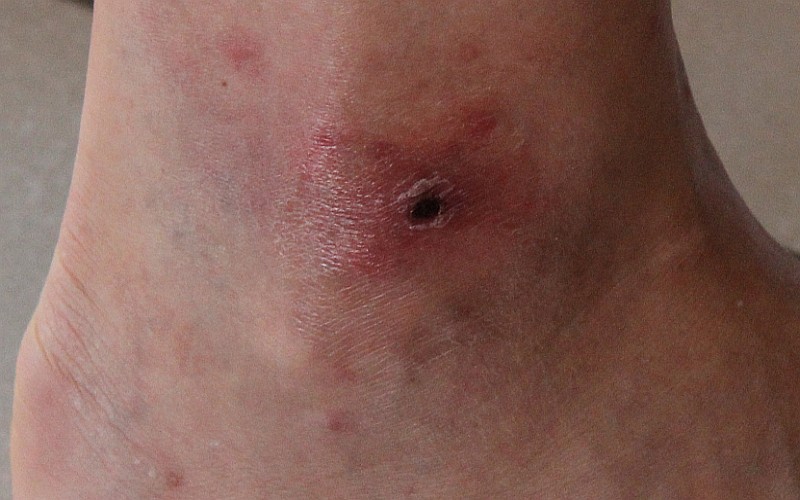African tick bite fever
| African tick bite fever | |
|---|---|

| |
| Synonyms | N/A |
| Pronounce | N/A |
| Specialty | N/A |
| Symptoms | Fever, headache, muscle pain, rash, eschar |
| Complications | Rarely neurological complications |
| Onset | 5 to 7 days after tick bite |
| Duration | Usually self-limiting within 2 weeks |
| Types | N/A |
| Causes | Rickettsia africae |
| Risks | Tick exposure in endemic areas |
| Diagnosis | Serology, PCR testing |
| Differential diagnosis | Malaria, typhoid fever, other rickettsial infections |
| Prevention | Avoiding tick bites, using insect repellent |
| Treatment | Doxycycline |
| Medication | N/A |
| Prognosis | Generally good with treatment |
| Frequency | Common in travelers to sub-Saharan Africa |
| Deaths | N/A |
== African Tick Bite Fever ==
African tick bite fever is an infectious disease caused by the bacterium Rickettsia africae. It is transmitted to humans through the bite of infected ticks, primarily of the Amblyomma genus. This disease is part of the spotted fever group of rickettsial infections.
Etiology[edit]
The causative agent of African tick bite fever is Rickettsia africae, a gram-negative, obligate intracellular bacterium. It is transmitted by ticks of the Amblyomma genus, particularly Amblyomma variegatum and Amblyomma hebraeum.
Epidemiology[edit]
African tick bite fever is endemic in sub-Saharan Africa and the Caribbean. It is considered a common travel-associated infection for individuals visiting rural areas in these regions. The disease is often reported in travelers returning from safaris or hiking trips.
Clinical Presentation[edit]
The incubation period for African tick bite fever is typically 5 to 7 days. The disease is characterized by the sudden onset of fever, headache, muscle pain, and a distinctive skin rash. A key feature is the presence of an eschar at the site of the tick bite, which is a necrotic lesion surrounded by a red halo.

Diagnosis[edit]
Diagnosis of African tick bite fever is primarily clinical, based on the presence of fever, rash, and eschar in a patient with a history of tick exposure in endemic areas. Laboratory confirmation can be achieved through serological tests or polymerase chain reaction (PCR) assays to detect Rickettsia africae DNA.
Treatment[edit]
The treatment of choice for African tick bite fever is doxycycline, an antibiotic effective against rickettsial infections. Treatment typically leads to rapid resolution of symptoms.
Prevention[edit]
Preventive measures include avoiding tick-infested areas, using insect repellents, wearing protective clothing, and performing regular tick checks after potential exposure. Travelers to endemic regions should be educated about the risks and preventive strategies.
Related Pages[edit]
Gallery[edit]
-
Amblyomma variegatum male
-
Amblyomma hebraeum
-
Leg lesion caused by African tick bite fever
-
Male Amblyomma variegatum tick
-
Amblyomma hebraeum tick
Ad. Transform your life with W8MD's Budget GLP-1 injections from $75


W8MD offers a medical weight loss program to lose weight in Philadelphia. Our physician-supervised medical weight loss provides:
- Weight loss injections in NYC (generic and brand names):
- Zepbound / Mounjaro, Wegovy / Ozempic, Saxenda
- Most insurances accepted or discounted self-pay rates. We will obtain insurance prior authorizations if needed.
- Generic GLP1 weight loss injections from $75 for the starting dose.
- Also offer prescription weight loss medications including Phentermine, Qsymia, Diethylpropion, Contrave etc.
NYC weight loss doctor appointmentsNYC weight loss doctor appointments
Start your NYC weight loss journey today at our NYC medical weight loss and Philadelphia medical weight loss clinics.
- Call 718-946-5500 to lose weight in NYC or for medical weight loss in Philadelphia 215-676-2334.
- Tags:NYC medical weight loss, Philadelphia lose weight Zepbound NYC, Budget GLP1 weight loss injections, Wegovy Philadelphia, Wegovy NYC, Philadelphia medical weight loss, Brookly weight loss and Wegovy NYC
|
WikiMD's Wellness Encyclopedia |
| Let Food Be Thy Medicine Medicine Thy Food - Hippocrates |
Medical Disclaimer: WikiMD is not a substitute for professional medical advice. The information on WikiMD is provided as an information resource only, may be incorrect, outdated or misleading, and is not to be used or relied on for any diagnostic or treatment purposes. Please consult your health care provider before making any healthcare decisions or for guidance about a specific medical condition. WikiMD expressly disclaims responsibility, and shall have no liability, for any damages, loss, injury, or liability whatsoever suffered as a result of your reliance on the information contained in this site. By visiting this site you agree to the foregoing terms and conditions, which may from time to time be changed or supplemented by WikiMD. If you do not agree to the foregoing terms and conditions, you should not enter or use this site. See full disclaimer.
Credits:Most images are courtesy of Wikimedia commons, and templates, categories Wikipedia, licensed under CC BY SA or similar.
Translate this page: - East Asian
中文,
日本,
한국어,
South Asian
हिन्दी,
தமிழ்,
తెలుగు,
Urdu,
ಕನ್ನಡ,
Southeast Asian
Indonesian,
Vietnamese,
Thai,
မြန်မာဘာသာ,
বাংলা
European
español,
Deutsch,
français,
Greek,
português do Brasil,
polski,
română,
русский,
Nederlands,
norsk,
svenska,
suomi,
Italian
Middle Eastern & African
عربى,
Turkish,
Persian,
Hebrew,
Afrikaans,
isiZulu,
Kiswahili,
Other
Bulgarian,
Hungarian,
Czech,
Swedish,
മലയാളം,
मराठी,
ਪੰਜਾਬੀ,
ગુજરાતી,
Portuguese,
Ukrainian


